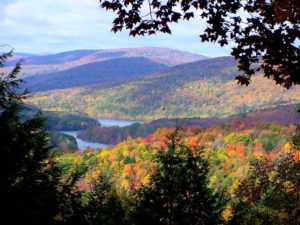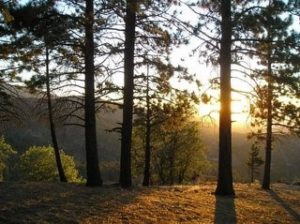Into The Woods: Connecting with Nature
Cindy Roe and Marie-Lise Baroutjian
NY Project Hope is a crisis counseling program that provides support and resources to help people cope with the challenges of the Covid-19 pandemic.
“We are now in the mountains and they are in us, kindling enthusiasm, making every nerve quiver, filling every pore and cell of us.”
– John Muir
 A New Buzzword that gained popularity during the pandemic, forest bathing refers to immersing oneself in nature in a mindful, intentional way. By communing with nature, the purpose of this form of self-care is for the person to not only take in all the wellness benefits from being in a natural setting, but also to inspire them to adopt a more eco-friendly mindset and become better stewards of the environment. Although this concept originated in Japan in the 1980s, forest bathing gained traction over the last year or so, thanks in large part to the shuttering of businesses; with nowhere else to go, people seeking a break from the monotony of homebound life flocked to parks and hiking trails in record numbers.
A New Buzzword that gained popularity during the pandemic, forest bathing refers to immersing oneself in nature in a mindful, intentional way. By communing with nature, the purpose of this form of self-care is for the person to not only take in all the wellness benefits from being in a natural setting, but also to inspire them to adopt a more eco-friendly mindset and become better stewards of the environment. Although this concept originated in Japan in the 1980s, forest bathing gained traction over the last year or so, thanks in large part to the shuttering of businesses; with nowhere else to go, people seeking a break from the monotony of homebound life flocked to parks and hiking trails in record numbers.
An interesting article from 2017 in Greater Good magazine notes that the connections between nature and personal health have been widely documented. Numerous research studies in recent years found that while being in a natural environment produced the highest increases in a person’s well-being, even viewing images of natural scenes still invoked sharp increases in positive emotions, such as awe, reverence, a sense of wonder, and gratitude among participants when compared to those who viewed other images. Similarly, another widely replicated study which examined the effect that living near green space had on city residents found that those who lived in close proximity to parks reported fewer ADHD and depression symptoms, a greater sense of calm, greater pride in where they live and a sense of connectedness to their neighbors. Importantly, the invocation of such positive emotions is also linked to prosocial tendencies, as evidenced by the scads of subsequent research that found a positive link between green space and crime; as it turns out, neighborhoods with more parks have historically had lower rates of violent crimes than other nature-deprived areas.
These positive emotions have also been identified as factors inherent in personal resilience. According to resilience theorists, highly resilient people are more likely to view problems from an objective rather than subjective viewpoint, meaning they’re better able to cope with what life throws their way because they see problems not as personal weaknesses but as challenges to be overcome and opportunities for personal growth.
 So, what is it about being outdoors that helps us feel better? One part of that answer comes from the scents found in nature. Conifer trees -aka evergreens- emit essential oils into the air that not only help ward off insects and microbes that could harm the tree, but that are also good for us. That slight hint of pine aroma we notice when we’re in an evergreen forest is chock full of beneficial nutrients called contain phytoncides, a group of naturally occurring chemicals that have been found to help calm the nervous system, reduce inflammation, and boost our immunity. In fact, naturalists espousing these health benefits are quick to note that pine needles, being a rich source of vitamin C, can be easily made into an herbal tea.
So, what is it about being outdoors that helps us feel better? One part of that answer comes from the scents found in nature. Conifer trees -aka evergreens- emit essential oils into the air that not only help ward off insects and microbes that could harm the tree, but that are also good for us. That slight hint of pine aroma we notice when we’re in an evergreen forest is chock full of beneficial nutrients called contain phytoncides, a group of naturally occurring chemicals that have been found to help calm the nervous system, reduce inflammation, and boost our immunity. In fact, naturalists espousing these health benefits are quick to note that pine needles, being a rich source of vitamin C, can be easily made into an herbal tea.
The scents, sights, and sounds of nature also affect the reward system of the body, which in turn shuts down the stress response. Because this exposure triggers the body to release dopamine and other feel-good chemicals, the body’s adrenal glands stop producing the cortisol, the hormone that’s responsible for the rapid heartbeat and sweaty palms we get when we’re feeling worried or scared. So, by spending time in nature, we come away feeling relaxed and rejuvenated not only because we get a much-needed break from our stress-filled lives, but also from the healthy dose of phytoncides we get from breathing in the fresh air.
Go On, Get Out There!
One of the best parts about connecting with nature is that there are endless options for outdoor activities that are relatively inexpensive, if not completely FREE! Check out this Video by NY Project Hope’s own Marie-Lise Baroutjian with some tips for enjoying nature. Also, here’s a short list of tips and top picks:
Go Slow and Be Present. Take your time! Our daily lives have us rushing to get so much done each and every day, so give yourself permission to shut off the mental chatter about your worries, at least for a little while, and devote your time and attention instead to taking in the beauty that’s all around you.
Use Your Senses. One way to be more fully present when you’re enjoying a natural setting is to utilize as many of your senses as possible. Look up from the ground when you’re walking along a trail; notice how the colors build and fade when you’re watching a glorious sunrise or sunset; give your full attention to the sounds around you; focus on what you feel with your feet- is the ground firm, soft, or spongy? Take off your shoes and walk barefoot in the grass or moss, or roll up your pants and dip your feet in the water of a stream or lake. Breathe deeply and notice the aromas of the flowers and trees.
 Find a Sit Spot. Choose a pretty spot nearby to sit, and just observe all that’s happening around you; spend time in this place as often as possible. After doing this awhile, you’ll begin to notice subtle changes and differences in the environment, such as the placement of the stars in the night sky, or the warming of the breezes as summer rolls around. Note to yourself when you see some firsts; when you first spot a firefly or dragonfly; when certain flowers begin to bloom; when you first hear crickets at dusk. Trust me, it’s mesmerizing.
Find a Sit Spot. Choose a pretty spot nearby to sit, and just observe all that’s happening around you; spend time in this place as often as possible. After doing this awhile, you’ll begin to notice subtle changes and differences in the environment, such as the placement of the stars in the night sky, or the warming of the breezes as summer rolls around. Note to yourself when you see some firsts; when you first spot a firefly or dragonfly; when certain flowers begin to bloom; when you first hear crickets at dusk. Trust me, it’s mesmerizing.
Also enjoy nature’s beauty throughout the year. Spring and summer are perfect for walking along wooded paths, and swimming in cool freshwater swim areas: our picks include Circleville Town Park, Creamery Rd. Circleville; Minnewaska State Park, Rte. 44/55 between Kerhonkson and New Paltz. In the fall, pack a hearty picnic lunch to enjoy after a leaf-peeping expedition on a crisp, sunny day; or ring in the holidays by donning some snowshoes for a trek through the newly fallen snow.
Bring the Outdoors In. Harvest some wildflowers to display in a pretty vase or pitcher. Black eyed susans, mountain laurel, wild flox, and queen anne’s lace are all just a few varieties of flowering plants that are in abundance in our area this time of year. Or potted plants, such as succulents, ivy plants, or even ferns can bring elements of nature inside during the colder months.
Watch the animals. Try your hand at birdwatching (ornithology)- you’d be surprised at how many different birds are also at home in your neighborhood. Challenge yourself to learn their calls and songs while you’re at it. Watch the squirrels or chipmunks playfully chase each other; or visit a nearby pond or lake and look for different wildlife.
Notice the plants and flowers. Why not try your hand at berry picking! June is strawberry season, while mid-July through most of August is prime time for peaches, cherries, apricots, and blueberries. Some options for you-pick farms include Lawrence Farms, Newburgh, NY, 845-562-4268; Ooch’s Farm, Warwick, NY, 845-986-1591.
Participate in natural area activities or even better, volunteer! Not only will you increase the time you spend outdoors, you’ll also build your knowledge and expertise about nature to boot, and make new connections to others. Local parks are often on the lookout for volunteers and offer numerous educational programs throughout the year. Our picks: Hudson Highlands Nature Museum, Cornwall, NY, 845-534-5506; Orange County Arboretum, Montgomery, info@orangecountyarboretum.org.
Notice How You Feel! Do a quick check in with yourself beforehand and note how you feel, then again during and after your time in nature; most of all, Enjoy!!
Remember, the Crisis Counselors for NY Project Hope at Independent Living are always available to help, since sometimes it can be helpful to talk to someone you don’t know. Want to know more about how we can help? Give us a call at 845-762-2275-talking to us is always free, voluntary, and confidential.
Visit Independent Living Inc on Facebook, Instagram, or on the web at www.myindependentliving.org for more blogs, tips and videos on stress management techniques and coping strategies. #iliprojecthope.
Cindy Roe and Marie-Lise Baroutjian are crisis counselors from Independent Living, Inc. working on with the NY Project Hope program.
For further reading:
What Happens When We Reconnect with Nature? By Kristophe Greene & Dacher Kelter, Greater Good Magazine.
How To Connect with Nature, by Brian Mertens, naturementor.com
Forest Bathing, healingforest.org

